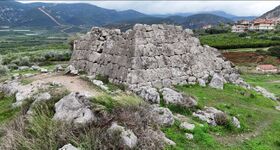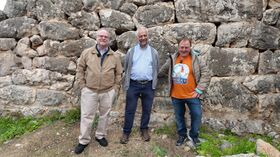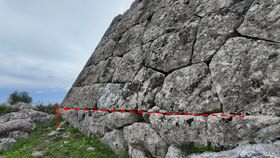Kurzstory: Die Pyramide von Hellinikon auf dem Peloponnes: Unterschied zwischen den Versionen
RMH (Diskussion | Beiträge) |
RMH (Diskussion | Beiträge) |
||
| Zeile 16: | Zeile 16: | ||
Bild 03 17 11 2025.jpg|Allein über die Funktion des Pyramidenstumpfes gehen die Meinungen auseinander. Eine einfache Extrapolation der Außenwände (gelbe Linien) zeigt, dass es nie eine geschlossene Pyramide mit Spitze war. Andere meinen, dass auf dem Pyramidenstumpf eine hölzerne Plattform zur Beobachtung stand. //<br>Opinions differ solely on the function of the truncated pyramid. A simple extrapolation of the outer walls (yellow lines) shows that it was never a closed pyramid with a peak. Others believe that a wooden observation platform stood on the truncated pyramid. | Bild 03 17 11 2025.jpg|Allein über die Funktion des Pyramidenstumpfes gehen die Meinungen auseinander. Eine einfache Extrapolation der Außenwände (gelbe Linien) zeigt, dass es nie eine geschlossene Pyramide mit Spitze war. Andere meinen, dass auf dem Pyramidenstumpf eine hölzerne Plattform zur Beobachtung stand. //<br>Opinions differ solely on the function of the truncated pyramid. A simple extrapolation of the outer walls (yellow lines) shows that it was never a closed pyramid with a peak. Others believe that a wooden observation platform stood on the truncated pyramid. | ||
| − | Bild 04 17 11 2025.jpg|Blick auf die unversehrte Nordostecke. Hier erkennt man, dass der pyramidale Oberteil auf einem rechteckigen, aber viel älteren rechteckigen Bauwerk steht (rote Linie). Laut Dr. Georgios Polymeris, den ich auf der Konferenz interviewte, sind unter diesem Unterbau auch die altertümlichen Gefäße (ca. 2.500 v. Chr.) gefunden und TL-Datierungen von Prof. | + | Bild 04 17 11 2025.jpg|Blick auf die unversehrte Nordostecke. Hier erkennt man, dass der pyramidale Oberteil auf einem rechteckigen, aber viel älteren rechteckigen Bauwerk steht (rote Linie). Laut Dr. Georgios S. Polymeris, den ich auf der Konferenz interviewte, sind unter diesem Unterbau auch die altertümlichen Gefäße (ca. 2.500 v. Chr.) gefunden und TL-Datierungen von Prof. Liritzis realisiert worden. Polymeris sieht in dem Stumpf eindeutige Belege für ein Bauwerk, das in der klassischen Hellenistik entstand! //<br>View of the intact northeast corner. Here, it is evident that the pyramidal upper section rests on a rectangular, but much older, rectangular structure (red line). According to Dr. Polymeris, whom I interviewed at the conference, ancient vessels (c. 2500 BC) were also found beneath this substructure, and TL dating was carried out by Prof. Liritzis. Polymeris sees in the stump clear evidence of a structure that originated in the Classical Hellenistic period! |
Bild 05 17 11 2025.jpg|In SO-Richtung weist das markante Eingangstor, das noch einen mächtigen Türsturz besitzt. Dahinter führt ein schmaler Gang, der in eine große Innenkammer führt. Dort finden sich wenig Hinweise auf die frühere Nutzung. Keramiken lassen auch keine Schlussfolgerung zu, dass es einst ein Grabmal war. //<br>The striking entrance gate, with its massive lintel, faces southeast. Behind it, a narrow passage leads to a large inner chamber. Little evidence of its former use can be found there. Ceramics also offer no indication that it was once a tomb. | Bild 05 17 11 2025.jpg|In SO-Richtung weist das markante Eingangstor, das noch einen mächtigen Türsturz besitzt. Dahinter führt ein schmaler Gang, der in eine große Innenkammer führt. Dort finden sich wenig Hinweise auf die frühere Nutzung. Keramiken lassen auch keine Schlussfolgerung zu, dass es einst ein Grabmal war. //<br>The striking entrance gate, with its massive lintel, faces southeast. Behind it, a narrow passage leads to a large inner chamber. Little evidence of its former use can be found there. Ceramics also offer no indication that it was once a tomb. | ||
| Zeile 24: | Zeile 24: | ||
</gallery> | </gallery> | ||
| − | ===Short Story: The Pyramid of | + | ===Short Story: The Pyramid of Hellinikon in the Peloponnese=== |
| − | '''During our conference in Patras, I had the opportunity, along with researchers from Portugal, Germany, and Greece, to visit the so-called Pyramid of | + | '''During our conference in Patras, I had the opportunity, along with researchers from Portugal, Germany, and Greece, to visit the so-called Pyramid of Hellinikon in the Peloponnese. This unusual, pyramid-shaped structure raises more questions than it answers—and that's precisely what makes it so fascinating.''' |
The prevailing view in archaeology is that the structure likely dates back to the Classical or Hellenistic period (c. 6th–3rd centuries BC) and probably served as a guard post or border station. However, some researchers believe that the structure may even date back to the 3rd millennium BC. | The prevailing view in archaeology is that the structure likely dates back to the Classical or Hellenistic period (c. 6th–3rd centuries BC) and probably served as a guard post or border station. However, some researchers believe that the structure may even date back to the 3rd millennium BC. | ||
| − | Opinions about its origin, purpose, and actual age vary widely. The discrepancy between conventional dating and alternative hypotheses makes the Pyramid of | + | Opinions about its origin, purpose, and actual age vary widely. The discrepancy between conventional dating and alternative hypotheses makes the Pyramid of Hellinikon a true archaeological enigma. |
| − | In short: The Pyramid of | + | In short: The Pyramid of Hellinikon is an extraordinary structure that defies easy historical categorization. Its study demonstrates how vibrant and open the discussion about the early architectural history of Greece still is. |
Version vom 17. November 2025, 13:53 Uhr
(dg) Im Rahmen unseres Fachkongresses in Patras hatte ich gemeinsam mit Forschern aus Portugal, Deutschland und Griechenland die Gelegenheit, die sogenannte Pyramide von Hellinikon auf dem Peloponnes zu besuchen. Dieses ungewöhnliche, pyramidenförmige Bauwerk wirft mehr Fragen auf, als es beantwortet — und genau das macht es so faszinierend.
Die gängige Auffassung der Archäologie lautet: Die Struktur stammt vermutlich aus der klassischen oder hellenistischen Zeit (ca. 6.–3. Jh. v. Chr.) und diente wahrscheinlich als Wach- oder Grenzstation. Manche Forscher vertreten jedoch die Auffassung, dass das Bauwerk sogar aus dem 3. Jts. v. Chr. stammen solle.
Die Meinungen über Herkunft, Zweck und tatsächliches Alter gehen weit auseinander. Die Diskrepanz zwischen konventioneller Datierung und alternativen Hypothesen macht die Helikon-Pyramide zu einem echten archäologischen Rätsel.
Kurzfazit: Die Helikon-Pyramide ist ein außergewöhnliches Bauwerk, das in keinem einfachen historischen Raster aufgeht. Ihre Erforschung zeigt, wie lebendig und offen die Diskussion über die frühe Baugeschichte Griechenlands noch immer ist.
Nahe der Stadt Argos/Griechenland in Sichtweise des Meeres steht prächtig auf einer Anhöhe die Helikon-Pyramide. Über Alter, Funktion und Ursprung wird immer noch heftig diskutiert. Leider hat das Bauwerk viele Schäden erlitten, so dass sie nur noch von der Südostseite einen prächtigen Eindruck macht. //
Near the city of Argos/Greece, with a view of the sea, the magnificent Pyramid of Helicon stands atop a hill. Its age, function, and origin are still hotly debated. Unfortunately, the structure has suffered much damage, so that it only presents a truly impressive appearance from the southeast side.Am Vortrag unserer Archäologie-Konferenz in Patras besuchten unsere Partner Dr. Nuno Ribeiro, Dr. Michael Rappenglück und ich das Bauwerk. Gemeinsam bestaunten wir die Bauweise und Architektur dieses Kolosses. Viele Archäologen hatten vor uns verschiedene Grabungen realisiert, die nur bedingt zur Aufklärung beitrugen. Die Analysen bieten zwei Haupteinordnungen: 1. Ein altertümliches Bauwerk um 2.500 v. Chr. – vor allem untermauert von Prof. Ioannis Liritzis TL-Datierungen. 2. Ein hellenistisches Bauwerk, das zwischen 600-400 v. Chr. datiert. //
On the day before our archaeology conference in Patras, our partners Dr. Nuno Ribeiro, Dr. Michael Rappenglück, and I visited the structure. Together, we admired the construction and architecture of this colossal building. Many archaeologists before us had carried out various excavations, which contributed only to a limited extent to our understanding. The analyses offer two main classifications: 1. An ancient structure dating to around 2.500 BC – primarily supported by Prof. Ioannis Liritzis' TL dating. 2. A Hellenistic structure built between 600 and 400 BC.Allein über die Funktion des Pyramidenstumpfes gehen die Meinungen auseinander. Eine einfache Extrapolation der Außenwände (gelbe Linien) zeigt, dass es nie eine geschlossene Pyramide mit Spitze war. Andere meinen, dass auf dem Pyramidenstumpf eine hölzerne Plattform zur Beobachtung stand. //
Opinions differ solely on the function of the truncated pyramid. A simple extrapolation of the outer walls (yellow lines) shows that it was never a closed pyramid with a peak. Others believe that a wooden observation platform stood on the truncated pyramid.Blick auf die unversehrte Nordostecke. Hier erkennt man, dass der pyramidale Oberteil auf einem rechteckigen, aber viel älteren rechteckigen Bauwerk steht (rote Linie). Laut Dr. Georgios S. Polymeris, den ich auf der Konferenz interviewte, sind unter diesem Unterbau auch die altertümlichen Gefäße (ca. 2.500 v. Chr.) gefunden und TL-Datierungen von Prof. Liritzis realisiert worden. Polymeris sieht in dem Stumpf eindeutige Belege für ein Bauwerk, das in der klassischen Hellenistik entstand! //
View of the intact northeast corner. Here, it is evident that the pyramidal upper section rests on a rectangular, but much older, rectangular structure (red line). According to Dr. Polymeris, whom I interviewed at the conference, ancient vessels (c. 2500 BC) were also found beneath this substructure, and TL dating was carried out by Prof. Liritzis. Polymeris sees in the stump clear evidence of a structure that originated in the Classical Hellenistic period!In SO-Richtung weist das markante Eingangstor, das noch einen mächtigen Türsturz besitzt. Dahinter führt ein schmaler Gang, der in eine große Innenkammer führt. Dort finden sich wenig Hinweise auf die frühere Nutzung. Keramiken lassen auch keine Schlussfolgerung zu, dass es einst ein Grabmal war. //
The striking entrance gate, with its massive lintel, faces southeast. Behind it, a narrow passage leads to a large inner chamber. Little evidence of its former use can be found there. Ceramics also offer no indication that it was once a tomb.Nochmals der Blick in SO-Richtung über den Pyramidenstumpf hinweg. Im Hintergrund erkennt man die gute strategische Position mit Blick aufs Umland und das Meer. Mich erinnerte das Bauwerk auf viele andere griechisch-römischen Pyramidenbauten, die von reichen Bürgern nach ihrer Rückkehr aus Ägypten errichtet wurden, um in verschiedener Weise auf die Prachtbauten im Niltal zu verweisen. Auf jeden Fall hat dieses Bauwerk keine Verwandtschaft zu echten ägyptischen Pyramiden sowie auf die Ausbreitung der Ziggurate, wie auf Sizilien, Sardinien oder Teneriffas. //
Once again, a view looking southeast over the truncated pyramid. In the background, one can see its strategically advantageous position overlooking the surrounding countryside and the sea. The structure reminded me of many other Greco-Roman pyramids erected by wealthy citizens upon their return from Egypt, intended in various ways to evoke the magnificent buildings of the Nile Valley. In any case, this structure bears no relation to genuine Egyptian pyramids, nor to the proliferation of ziggurats, as seen in Sicily, Sardinia, or Tenerife.
Short Story: The Pyramid of Hellinikon in the Peloponnese
During our conference in Patras, I had the opportunity, along with researchers from Portugal, Germany, and Greece, to visit the so-called Pyramid of Hellinikon in the Peloponnese. This unusual, pyramid-shaped structure raises more questions than it answers—and that's precisely what makes it so fascinating.
The prevailing view in archaeology is that the structure likely dates back to the Classical or Hellenistic period (c. 6th–3rd centuries BC) and probably served as a guard post or border station. However, some researchers believe that the structure may even date back to the 3rd millennium BC.
Opinions about its origin, purpose, and actual age vary widely. The discrepancy between conventional dating and alternative hypotheses makes the Pyramid of Hellinikon a true archaeological enigma.
In short: The Pyramid of Hellinikon is an extraordinary structure that defies easy historical categorization. Its study demonstrates how vibrant and open the discussion about the early architectural history of Greece still is.





